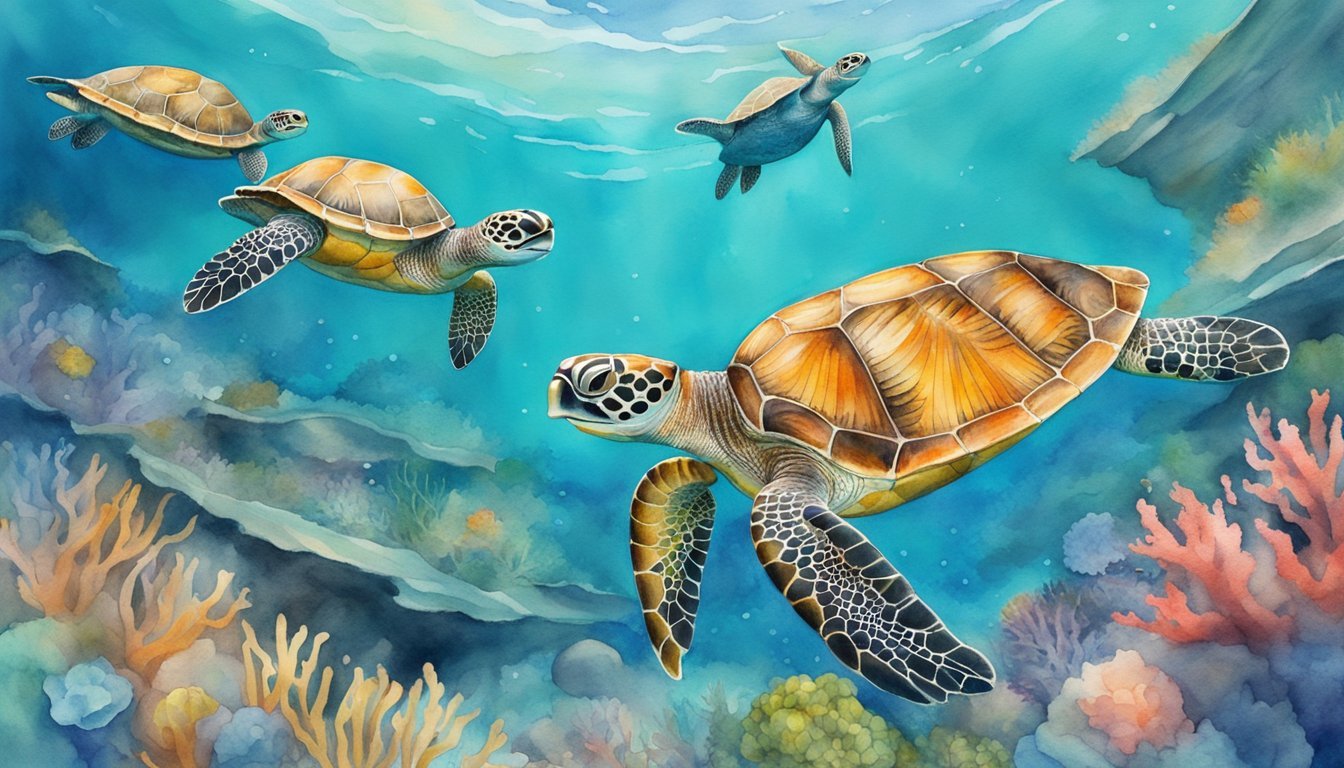Turtle Basics
Species Diversity
Turtles are an ancient group of reptiles with a remarkable diversity, over 300 species belonging to the order Testudines. They can be broadly classified into two suborders: Pleurodira and Cryptodira. Some well-known turtle species include the leatherback, green, hawksbill, and olive ridley. While all turtles have a few things in common, such as the presence of a shell, there is great variation in size, habitat, and appearance among the different species.
Anatomy and Adaptations
One of the most distinctive features of turtles is their bony shell, which acts as a protective shield. The shell is made up of two main parts: the carapace (the top part) and the plastron (the bottom part). These parts consist of a series of bones that are fused together and covered in uniquely patterned scales called scutes.
As reptiles, turtles are ectothermic, meaning they rely on external heat sources to regulate their body temperature. They have developed various adaptations to survive in a wide range of environments. For example, aquatic turtles like the leatherback have streamlined shells and strong flippers for efficient swimming, while terrestrial species, such as tortoises, have a more dome-shaped shell and sturdy limbs for moving on land.
Turtle Habitats
Turtles can be found in various habitats around the world, from tropical seas to arid deserts. For instance, sea turtles are mainly aquatic creatures who spend their lives in oceans, feeding on jellyfish and other marine life. On the other hand, some turtles like the hawksbill inhabit coastal waters and coral reefs, where they feed on sponges and contribute to maintaining a healthy ecosystem.
In contrast, tortoises are terrestrial animals, and their habitats often include grasslands, forests, and even deserts. Due to their unique adaptations, turtles have been able to thrive in diverse environments and play essential roles in their ecosystems. However, many turtle species now face threats from habitat loss, pollution, and climate change, which highlights the importance of conservation efforts to protect these fascinating creatures.
Turtle Conservation and Threats

Reproduction and Lifecycle
Sea turtles have a fascinating reproduction and lifecycle. Female turtles migrate long distances to lay their eggs on sandy beaches. They usually lay around 50 to 200 eggs, known as a clutch, and cover the nest with sand to protect it from predators. After 45 to 75 days, hatchlings emerge from the nest and make their way to the water. Juvenile turtles have diverse diets, including jellyfish, mollusks, sponges, invertebrates, and algae. As they grow, their diet becomes more specialized; for example, green sea turtles are primarily herbivorous, while leatherback sea turtles feed on carnivorous prey like jellyfish.
Dangers to Turtles
Sea turtles face numerous threats throughout their lives. Many predators, including humans, target turtle eggs and hatchlings. Fishing, especially bycatch, also poses a significant danger to sea turtles. Bycatch is the accidental capture of sea turtles in fishing gear, and it is the top threat to their populations. Pollution, such as plastic waste, oil spills, and chemical runoff, impacts turtles’ health, sometimes leading to fatalities. Climate change also poses a threat to turtle populations by disrupting nesting habitats and altering migratory patterns.
Conservation Efforts
Conservationists strive to protect all seven species of sea turtles, including the leatherback, green, hawksbill, and Kemp’s ridley. These efforts include using turtle excluder devices in fishing nets to prevent sea turtles from becoming bycatch. Additionally, monitoring and patrolling nesting beaches help protect turtle eggs from poaching and predators. Public awareness is crucial for sea turtle conservation. Recognizing the threats these creatures face and how humans can mitigate them is essential for their survival.
In conclusion, sea turtles are remarkable creatures that face numerous threats globally. Conservation efforts to protect their nesting habitats, reduce bycatch in fishing, and maintain healthy populations with diverse diets are vital for ensuring the survival of these ancient mariners.

